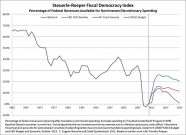America has enormous power, but the Biden Administration and the Federal Reserve are abusing it.
The Fed and the Future of America's Debt
Two recent headlines in the Wall Street Journal speak to America’s changing economic landscape: “Top Fed Official Says New Framework Provides More Humble Approach to Setting Rates” (August 31), and “U.S. Debt Is Set to Exceed Size of the Economy Next Year, a First Since World War II” (September 2).
In my view, the second of these stories provides more insight than the first into what the Federal Reserve will be doing in the months and years ahead. For all of the focus that journalists place on monetary policy, the Fed is ultimately a central bank. And, as Niall Ferguson pointed out in The Cash Nexus, historically the role of a central bank is to enable governments to borrow. Ferguson pointed out that as wars became expensive, rulers found that success in war required the ability to conduct wars on credit, and they discovered that a central bank could help to direct credit their way.
Getting Out of Debt
A major function of government intervention in financial markets, whatever its stated purpose, is to direct credit toward the government and its preferred activities. For example, risk-based capital requirements are nominally an attempt to promote safety and soundness in banking. But by minimizing the capital required to back holdings of government securities, these regulations create an incentive for banks to invest in government debt. The housing bubble that preceded the 2008 financial crisis was exacerbated by risk-based capital rules that gave favored treatment to bank investment in mortgage-backed securities, which in turn was driven by a powerful housing finance lobby.
What I will argue here is that for the next several years the Fed will be focused on the task of enabling the government to continue to borrow. The conduct of what economists call monetary policy will be subordinated to that objective. The Fed will be expected to finance as much government borrowing as is necessary to keep interest costs under control. But regardless of how active the Fed is in purchasing government bonds, I believe that the United States will slide into a regime of high inflation.
The ratio of U.S. Government debt to one year’s GDP is now in the neighborhood of 100 percent, a level last seen in World War II. IMF economists Carmen M. Reinhart and M. Belen Sbrancia have written:
Throughout history, debt/GDP ratios have been reduced by (i) economic growth; (ii) substantive fiscal adjustment/austerity plans; (iii) explicit default or restructuring of private and/or public debt; (iv) a surprise burst in inflation; and (v) a steady dosage of financial repression accompanied by an equally steady dosage of inflation.
Between 1950 and 1974, the United States reduced its debt/GDP ratio from 79 percent to 24 percent. Economic growth was high, which meant that GDP was rising rapidly. Moreover, most of those years, the government was running a “primary surplus,” even though it was reporting deficits. The reported deficit includes interest payments on the debt, but because receipts exceeded non-interest spending, the outstanding principal was being reduced. Moreover, while the rest of the budget was in deficit, Social Security was in surplus, and government accounting did not combine the two until the end of the Johnson Administration. Had this “unified budget” been measured prior to then, it would have reported many years of surplus.
The prospects for a repeat of the post-World War II experience of falling debt/GDP ratios are poor. Economic growth over the past 50 years has remained well below the levels achieved in the 1950s and 1960s. Social Security no longer contributes to the surplus, because the ratio of beneficiaries to workers is much higher than it was back then. Also, Medicare has become another large strain on fiscal resources. Finally, the willingness of leaders in Washington to forego current desires in order to maintain fiscal discipline has evaporated.
As economist John Cochrane put it recently:
In short, the US grew out of WWII debt by not borrowing any more, by decades of fiscal probity, and by strong supply-side growth in a deregulated economy. We have none of these reassurances going forward. And this, and the UK exit from Napoleonic War debt in the 1800s by starting the industrial revolution are about the only historical examples of a semi-successful repayment of this much debt. Otherwise, the history of large sovereign debts is one long sorry tale of default, inflation, devaluation, and consequent financial chaos.
If neither economic growth nor primary surpluses are likely to emerge to bring down the debt/GDP ratio, that leaves the other options discussed by Reinhart and Sbrancia: hard default; soft default via surprise inflation; and financial repression with well-anticipated inflation.
In my view, all attempts to predict inflation using mechanical rules fail because inflation depends on the habits, norms, and expectations of the public at large.
Hard default would mean that the government would explicitly pay bondholders less than the full principal and interest owed. Many governments have done this, and some governments are even “serial defaulters,” as described in Reinhart’s book with Ken Rogoff, This Time is Different. But hard default would be unprecedented for the U.S.
Financial repression occurs when the government makes it impossible for interest rates to rise enough to offset inflation. In order to work, financial repression requires stringent controls on capital markets. To get savers to accept interest rates on government debt that fail to cover inflation, regulators have to close off the alternatives, both domestic and foreign. Otherwise, capital will flee government debt for private securities and foreign obligations. This sort of financial repression has been common in the underdeveloped world where private capital markets are poorly developed, but it would seem to have little chance in the financially sophisticated United States.
The Transition to a High-Inflation Regime?
That leaves surprise inflation as the least implausible mechanism for lowering the ratio of debt to GDP in the United States. Certainly, if we do experience high inflation some time in the next decade, many people will be surprised. In fact, the best market estimate of expected future inflation, which is the spread between Treasury bonds that are indexed for inflation and non-indexed securities, indicates that investors expect inflation over the next 10 years to average less than 2 percent per year.
One reason to expect inflation to remain tame is the belief that the Fed can use models of inflation to anticipate and stamp out high inflation. One popular model links higher inflation to low unemployment. This is known as the Phillips Curve. But as the first article mentioned above points out, this model has not predicted well in recent years (in fact, it has not predicted well in the last five decades).
Another popular model links higher inflation to the quantity of money. The Achilles heel of this conventional monetarism is choosing the definition of money. Money can be defined very narrowly as the liabilities of the Federal Reserve System (currency and bank reserves). It can be defined very widely to include any liquid asset, such as bank deposits or money market fund accounts. Or it can be defined somewhere in between. The narrower the definition, the more closely the Fed can control the money supply, but the weaker the correlation of the money supply with inflation. The wider the definition, the stronger the correlation with inflation, but the less control the Fed has over the money supply.
In my view, all attempts to predict inflation using mechanical rules fail. They fail because inflation depends on the habits, norms, and expectations of the public at large. If people are habituated to low inflation, then attempts by the Fed to nudge up the inflation rate will not work. In fact, over the last decade, inflation has almost always come in under the Fed’s announced targets. Conversely, if people believe that inflation will be high and variable, then they try their best to protect against this: they shorten the term of agreements; they incorporate cost-of-living escalators into labor bargains; they minimize their holdings of currency or other non-interest-bearing assets. In the United States, we last saw these behaviors in the high-inflation era of the 1970s. They served to reinforce the high-inflation regime, and it took the entire decade of the 1980s to return to an era of low and stable inflation.
Because of the importance of expectations of inflation that are embedded in habits and norms, an economy will tend to gravitate toward one of two regimes: a low-inflation regime, in which inflation is low and steady; or a high-inflation regime, in which inflation is high and variable.
A scenario that I find plausible is that by 2030 the United States will have transitioned to a high-inflation regime. The Federal Reserve will be powerless to prevent such a transition. If it attempts contractionary policies, the interest rate on government debt will go up. With the debt/GDP ratio as high as it is, this would threaten a fiscal crisis by sharply raising the amount of tax revenue that has to be devoted to making interest payments. If instead, the Fed seeks to hold down the government’s interest costs, it will have to do so by making massive new purchases of government bonds, thereby putting more monetary fuel onto the inflationary fire.
The surprise inflation will cause a massive redistribution of wealth, with the value of many assets eroded because they are not indexed to inflation. Just as during the German hyperinflation, a large swath of the population will see its savings wiped out.
I should stress that the outlook sketched above is not the majority view among economists or market participants. But I cannot fathom how the majority thinks that the debt/GDP ratio is going to come down in a benign fashion.



